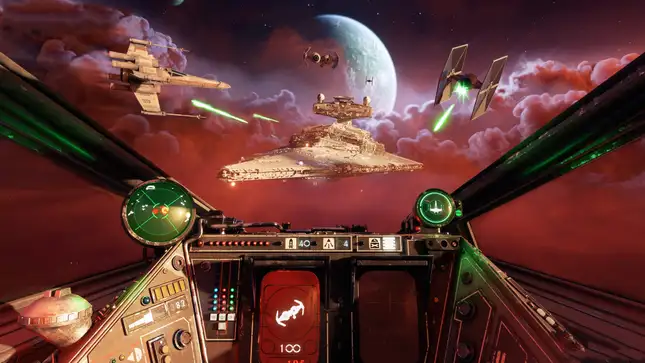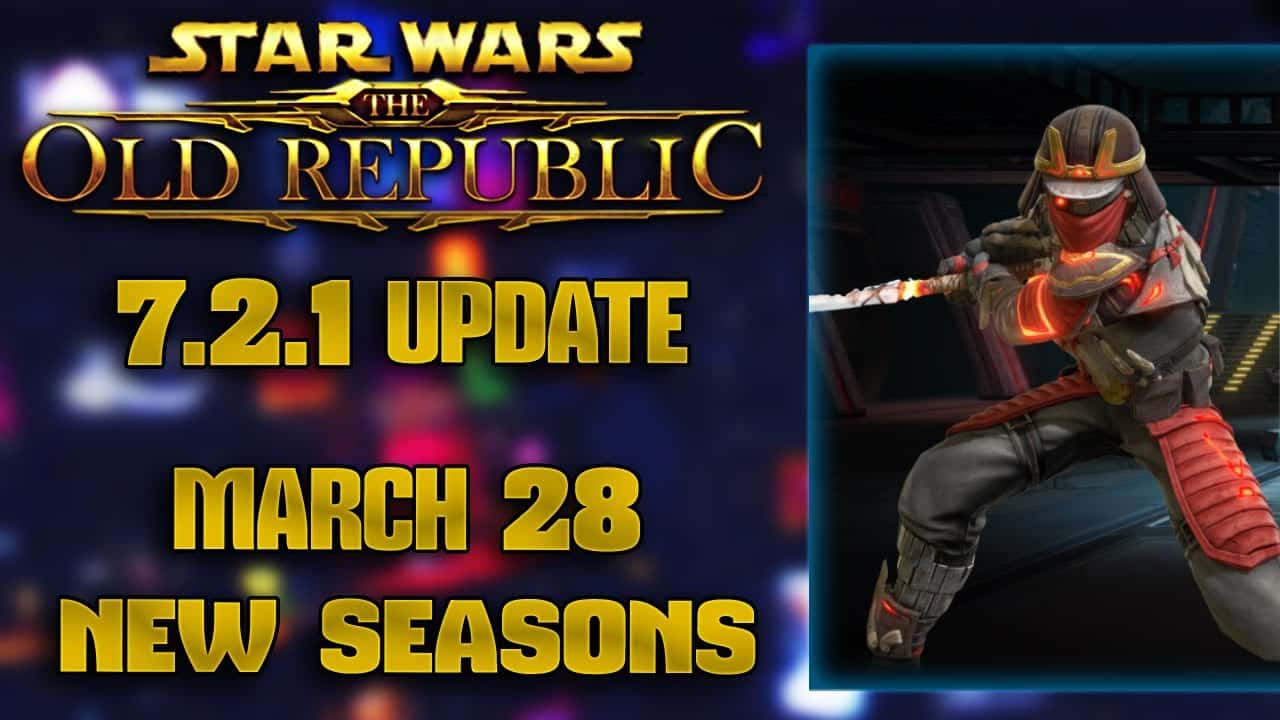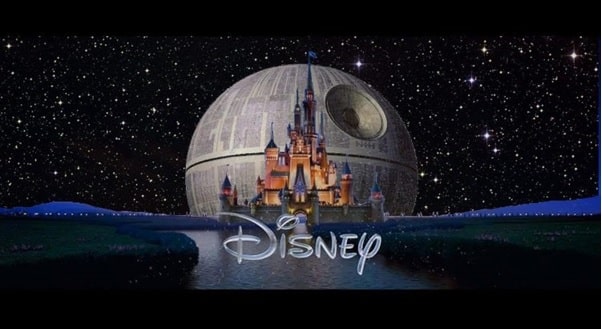Buckle up, Star Wars fans! We’re about to embark on a hyperspace journey through the thrilling evolution of space combat in the realm of “Star Wars” games. From the pixelated battles of yesteryears to the immersive dogfights in “Star Wars: Squadrons,” this galaxy has seen it all. But how did we get here? Let’s dive in and find out.
The Early Days: A Pixelated Galaxy Far, Far Away
The genesis of space combat in “Star Wars” games is a tale of humble beginnings, pioneering spirits, and pixelated adventures that sparked the imaginations of a generation. It’s a journey that started in a time when video games were a nascent industry, and the idea of bringing the sprawling Star Wars universe into our living rooms was nothing short of revolutionary.
Back in the day, graphics were more about suggestion than detail. Every pixel had to count, every beep and boop from the sound chip had to convey a part of the story that the graphics couldn’t. These early “Star Wars” games were far from the high-definition, surround-sound experiences we’re accustomed to today. But, oh, did they have heart!
- The Birth of a Legacy: It all began with simple yet groundbreaking titles like “Star Wars: The Empire Strikes Back” for the Atari 2600. This game put players in the cockpit of a snowspeeder on Hoth, challenging them to take down AT-ATs in a blocky, 2D landscape. It was crude by today’s standards, but at the time, it was like holding a piece of the movie in your hands.
- Pushing Boundaries with “Star Wars: X-Wing”: As technology progressed, so did the ambition of “Star Wars” games. The early ‘90s saw the release of “Star Wars: X-Wing,” a game that was a quantum leap forward in terms of graphics and gameplay. This game wasn’t just about shooting TIE fighters; it was about being a part of the Rebel Alliance, experiencing missions that felt lifted straight from the movies. The sense of scale, the tension of dogfights, and the satisfaction of a successful mission were unparalleled at the time.
- The Role of Imagination: What these early games lacked in graphical prowess, they more than made up for with the power of imagination. Players were transported into the Star Wars universe not just by what they saw, but by what they envisioned could be happening beyond the screen’s limitations. Each pixelated explosion wasn’t just a visual effect; it was the destruction of an Imperial threat, each mission not just a level, but a critical blow to the Empire’s tyranny.
- Community and Culture: These games also played a pivotal role in building the Star Wars gaming community. Arcades and living rooms became hubs of shared experiences, with players discussing strategies, sharing tips, and reliving their favorite moments from the games. It was a time of bonding, not just over a shared love for Star Wars, but over the shared experience of exploring it in a whole new way.
In these early days of pixelated graphics and chiptune soundtracks, the foundations were laid for what would become a sprawling and beloved part of the Star Wars universe. The games might have been limited by the technology of their time, but they were boundless in their ability to capture our hearts and imaginations. As we look back at these pioneering titles, we can’t help but feel a sense of nostalgia and appreciation for how far we’ve come – and it all started in this pixelated galaxy far, far away.
The Middle Years: Graphical Leap and Storytelling Depth
As we venture forward in our exploration of the “Star Wars” gaming universe, we arrive at a pivotal era that I like to call the Middle Years. This period was marked by significant advancements in technology, which in turn allowed for a dramatic leap in both graphics and storytelling within “Star Wars” games. It was a time when the galaxy far, far away didn’t just look more realistic; it felt more real.
- Graphical Revolution: The late ’90s and early 2000s witnessed a technological renaissance in gaming, and “Star Wars” games were at the forefront of this revolution. Games like “Star Wars: Rogue Squadron” and “Star Wars: Jedi Knight II: Jedi Outcast” brought the universe to life in ways we’d never seen before. These titles boasted improved 3D graphics, making planets, starships, and characters more realistic and immersive. Suddenly, you weren’t just playing in the Star Wars universe; you were a part of it.
- Expanding the Lore: This era wasn’t just about better graphics; it was also about richer storytelling. Games began to delve deeper into the lore of the Star Wars universe, exploring stories that were untold in the movies. Titles like “Star Wars: Knights of the Old Republic” took players thousands of years before the original trilogy, offering a fresh perspective on the galaxy and its history. These stories weren’t just spin-offs; they were integral chapters that expanded our understanding and appreciation of the Star Wars saga.
- Emotional Engagement and Character Development: As storytelling evolved, so did the emotional depth of the games. Players became more than just spectators; they became participants in narratives that were complex and engaging. Characters in these games were no longer just avatars; they had backstories, motivations, and arcs that players could relate to and care about. This deepened emotional engagement made victories more triumphant, losses more poignant, and the overall experience more memorable.
- Gameplay Evolution: Alongside graphical and narrative advancements, gameplay also saw significant improvements. Combat became more varied and tactical, space battles more intense and strategic. Games started to incorporate different genres, from first-person shooters to role-playing games, ensuring that there was something for every type of gamer. This era saw the birth of iconic gameplay elements that are still cherished by fans today.
- Community and Multiplayer Experiences: The Middle Years also ushered in a new era of community and multiplayer experiences. With the advent of internet gaming, players could now join forces or compete against each other from across the globe. This connectivity not only enhanced the gameplay experience but also strengthened the global Star Wars gaming community, fostering friendships and rivalries that transcended geographical boundaries.
The Middle Years of “Star Wars” gaming were a time of growth, exploration, and innovation. The leaps in graphical fidelity and storytelling depth transformed the way fans interacted with the Star Wars universe. These games didn’t just entertain; they enriched the lore and left an indelible mark on the hearts and minds of players. As we reflect on this era, it’s clear that these advancements set the stage for the breathtaking experiences that would follow in the years to come.
The Modern Era: Immersion Like Never Before in “Star Wars: Squadrons”
The closing down of “Star Wars: Squadrons” marks the end of an era in the “Star Wars” gaming universe, but it also provides a perfect opportunity to reflect on the monumental impact this game had during its prime. “Star Wars: Squadrons” wasn’t just a game; it was a groundbreaking achievement in immersive gameplay and a beacon of the modern era of “Star Wars” games.
- Unprecedented Immersion: “Star Wars: Squadrons” set a new standard for immersion in video games. The game’s VR compatibility offered a level of realism that was previously unimaginable. Players could literally look around their cockpits, track enemy fighters with their eyes, and feel the intensity of space combat like never before. This wasn’t just playing a game; it was stepping into a different reality.
- Revolutionary Graphics and Sound Design: The attention to detail in “Squadrons” was extraordinary. From the intricate designs of the starfighters to the vastness of space, every visual element was crafted to perfection. The sound design, too, was impeccable, with roaring engines, whizzing lasers, and the iconic sounds of “Star Wars” all combining to create an auditory experience that was as authentic as it was thrilling.
- Engaging Gameplay Mechanics: The game struck a delicate balance between accessibility and depth in its gameplay. Piloting a starfighter felt intuitive yet challenging, appealing to both casual gamers and hardcore flight sim enthusiasts. The game mechanics encouraged players to truly master their ships, learning the nuances of each class and how to best utilize their unique abilities in battle.
- Impact on the “Star Wars” Community: “Star Wars: Squadrons” created a vibrant community of players, united by their love for high-octane space battles and the “Star Wars” universe. The game’s multiplayer mode brought together players from around the world, fostering camaraderie, competition, and endless hours of fun. It wasn’t just about winning or losing; it was about sharing an experience that was uniquely “Star Wars.”
- A Legacy of Inspiration: Even though “Squadrons” has been closed down, its legacy lives on. It pushed the boundaries of what’s possible in a “Star Wars” game and inspired future game developers to dream bigger. The lessons learned and the technological advancements made with “Squadrons” will undoubtedly influence the next generation of “Star Wars” games.
- Reflecting on the Journey: The closure of “Star Wars: Squadrons” is a bittersweet moment. It signifies the end of a chapter but also reminds us of the journey we’ve been on since the early days of pixelated graphics. “Squadrons” was a testament to how far “Star Wars” games have come and a beacon of what they could be in the future.
The modern era of “Star Wars” gaming, epitomized by “Star Wars: Squadrons,” was a period of unparalleled innovation and enjoyment. It showed us the potential of video games as a medium for storytelling and immersion, pushing the envelope in both technology and creativity. As we bid farewell to “Squadrons,” we look forward to the future, excited for the next groundbreaking experience that will take us once again to that galaxy far, far away.
What’s Next? The Future of Space Combat in “Star Wars” Games
As we close the chapter on the iconic “Star Wars: Squadrons” and reminisce about the journey from the pixelated origins to the VR-enhanced realities, we can’t help but wonder: What’s next for space combat in “Star Wars” games? The future, much like space itself, is vast and full of possibilities. Let’s speculate on the potential directions and innovations that could shape the next era of “Star Wars” gaming.
- Advancements in Virtual Reality: The success of VR in “Star Wars: Squadrons” has only scratched the surface of potential. Imagine a future where VR technology becomes even more advanced, offering full-body haptic feedback suits, allowing players to feel the G-forces of space combat or the impact of laser fire. This could transform gaming into a fully immersive experience, blurring the lines between reality and the virtual world.
- Augmented Reality Experiences: Augmented reality (AR) has the potential to bring the “Star Wars” universe into our physical world. Picture an AR game where you can turn your living room into the cockpit of a Millennium Falcon, or your backyard into the surface of Tatooine. AR could allow for a more social and physically active gaming experience, attracting a new wave of fans to the franchise.
- AI and Procedurally Generated Galaxies: With advancements in artificial intelligence and procedural generation, future “Star Wars” games could offer galaxies that are ever-expanding and unique for each player. Imagine a game where you could explore uncharted planets, encounter new species, and experience stories that are generated in real-time, tailored to your actions and decisions.
- Cross-Platform and Cross-Reality Play: The future could see the integration of various gaming platforms and realities. Players on traditional consoles, PCs, VR, and AR could all participate in the same game world, each bringing a different perspective and set of capabilities to the mission at hand. This would not only unite different types of gamers but also provide a diverse and dynamic gaming environment.
- Narrative Depth and Player Choice: As technology evolves, so does the potential for storytelling. Future “Star Wars” games could offer more complex narratives, where player choices have significant consequences, leading to multiple endings and personalized story arcs. This would encourage replayability and ensure that each player’s journey through the galaxy is unique.
- Integration with Other Media: The future of “Star Wars” games could see deeper integration with films, TV series, and books. Games could serve as direct continuations of movie storylines or fill in the gaps between episodes. This transmedia storytelling would create a more cohesive and immersive Star Wars universe, where each medium complements and enhances the others.
- Environmental and Ethical Storytelling: With growing awareness of environmental and ethical issues, future “Star Wars” games could incorporate these themes into their narratives. Games could explore the impact of war on the galaxy’s ecology or the moral dilemmas faced by characters in a universe torn by conflict. This would not only make for compelling storytelling but also resonate with contemporary concerns.
The future of space combat in “Star Wars” games is as boundless as the universe in which they are set. With each technological advancement and creative innovation, we move closer to experiences that we can currently only dream of. As we look to the stars, one thing is certain: the “Star Wars” gaming universe will continue to evolve, inspire, and transport us to a galaxy far, far away.
Conclusion: The Force is Strong with “Star Wars” Games
As we conclude our exploration of the evolution of space combat in “Star Wars” games, it’s clear that this journey has been about much more than the progression of graphics and gameplay. It’s a saga that has paralleled our own technological and cultural advancements, reflecting how we interact with and perceive the universe George Lucas created over four decades ago.
- A Reflection of Our Technological Journey: The evolution of “Star Wars” games is a mirror to our own technological advancements. From the early days of pixelated screens to the immersive virtual realities of today, each phase in this journey has been a testament to human ingenuity and the relentless pursuit of bringing imagination to life. As technology continues to leap forward, so too will the ways in which we experience and interact with the “Star Wars” galaxy.
- More Than Games – Cultural Phenomena: “Star Wars” games have transcended the realm of entertainment to become cultural phenomena. They’ve influenced not just gaming culture but broader pop culture, inspiring a sense of wonder and adventure in generations of fans. They’ve become a platform for storytelling, community building, and shared experiences that extend far beyond the confines of individual gameplay.
- The Role of Community and Fandom: The enduring success of “Star Wars” games is, in no small part, due to the passionate community that has grown around them. This community has been a driving force, pushing for advancements, celebrating the franchise’s successes, and even helping to shape future games through their feedback and enthusiasm. As we look to the future, this community will undoubtedly continue to be a vital part of the “Star Wars” gaming universe.
- Educational and Inspirational Impact: Beyond entertainment, “Star Wars” games have educational and inspirational impacts. They’ve sparked interest in technology, space exploration, and storytelling. For many, these games have been a gateway to careers in programming, design, and other creative industries. They’ve shown us that the boundaries of what we can create and experience are only limited by our imagination.
- The Future – A Canvas of Possibilities: As we ponder the future of “Star Wars” games, it’s like staring into a sky full of stars, each point of light representing a possibility. We stand at the threshold of new adventures, technologies, and stories that will continue to expand and enrich the “Star Wars” universe. Whether it’s through augmented reality, deeper narrative experiences, or yet-to-be-invented gaming platforms, the potential for what comes next is as vast as the galaxy itself.
- A Timeless Connection: Finally, it’s important to recognize that at the heart of the “Star Wars” gaming evolution is a timeless connection to the themes of hope, adventure, and the eternal struggle between good and evil. These themes resonate across generations, cultures, and technological eras, making “Star Wars” games much more than just a pastime; they are a shared language, a way to connect with others and with a story that continues to inspire and entertain.
In closing, the journey of space combat in “Star Wars” games is an ongoing narrative, rich with history, achievements, and community. It’s a narrative that has both shaped and been shaped by its audience, reflecting our desires, our advancements, and our dreams. As we look forward to the next chapter in this extraordinary saga, we do so with the anticipation that the best is yet to come, ready to continue our adventure in the ever-expanding universe of “Star Wars” games.
FAQ: The Evolution of Space Combat in “Star Wars” Games
- What was the first “Star Wars” space combat game?
- The first game to introduce space combat in the “Star Wars” universe was “Star Wars: The Empire Strikes Back” for the Atari 2600, released in 1982.
- How did “Star Wars: X-Wing” impact space combat games?
- “Star Wars: X-Wing,” released in the early ’90s, was a groundbreaking game that set a new standard for space combat with its detailed graphics, immersive gameplay, and faithful representation of the “Star Wars” universe.
- What made “Star Wars: Squadrons” unique in the series?
- “Star Wars: Squadrons” stood out for its highly immersive VR compatibility, detailed cockpits, and realistic space combat mechanics, offering an unparalleled experience in piloting starfighters.
- How has storytelling evolved in “Star Wars” games?
- Over the years, “Star Wars” games have evolved from simple narratives to complex stories with deep lore, character development, and choices affecting the game’s outcome, as seen in titles like “Star Wars: Knights of the Old Republic.”
- Will there be more “Star Wars” space combat games in the future?
- While specific titles have not been announced, the enduring popularity of the “Star Wars” franchise suggests that more space combat games are likely in development, potentially featuring advancements in VR, AR, and AI technology.
- Can I still play older “Star Wars” space combat games?
- Yes, many older “Star Wars” games are available on digital platforms and often see re-releases or compatibility updates for modern systems.
- How have “Star Wars” games influenced the gaming industry?
- “Star Wars” games have been influential in setting high standards for graphics, storytelling, and immersive gameplay, inspiring developers and shaping gaming trends in space combat and beyond.
- Are “Star Wars” games suitable for all ages?
- Most “Star Wars” games are designed to be family-friendly and are suitable for a wide range of ages, but it’s always recommended to check the specific game rating for age-appropriateness.






